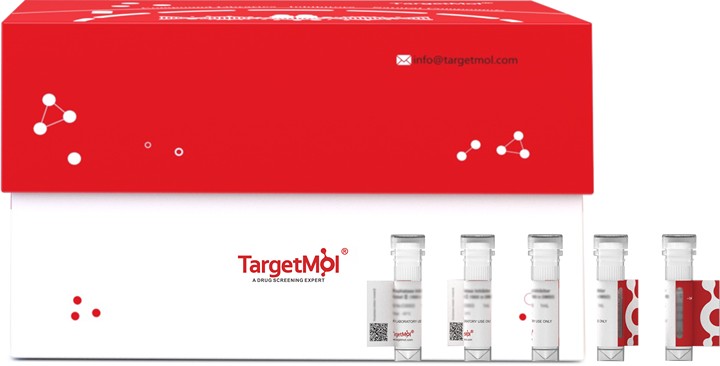购物车
全部删除  您的购物车当前为空
您的购物车当前为空
TrkA Protein, Mouse, Recombinant (hFc) is expressed in HEK293 mammalian cells with hFc tag. The predicted molecular weight is 69.2 kDa and the accession number is Q3UFB7.

| 规格 | 价格 | 库存 | 数量 |
|---|---|---|---|
| 5 μg | ¥ 428 | 6-8日内发货 | |
| 10 μg | ¥ 683 | 6-8日内发货 | |
| 20 μg | ¥ 1,130 | 5日内发货 | |
| 50 μg | ¥ 2,270 | 5日内发货 | |
| 100 μg | ¥ 4,430 | 5日内发货 |
| 生物活性 | Measured by its ability to inhibit NGF-induced proliferation of TF‑1 human erythroleukemic cells. The ED50 for this effect is typically 0.02-0.08 µg/mL in the presence of 10 ng/mL of recombinant mouse NGF. |
| 产品描述 | TrkA Protein, Mouse, Recombinant (hFc) is expressed in HEK293 mammalian cells with hFc tag. The predicted molecular weight is 69.2 kDa and the accession number is Q3UFB7. |
| 种属 | Mouse |
| 表达系统 | HEK293 Cells |
| 标签 | C-hFc |
| 蛋白编号 | Q3UFB7 |
| 别名 | TrkA,trk,Tkr,neurotrophic tyrosine kinase, receptor, type 1,C80751 |
| 蛋白构建 | A DNA sequence encoding the mouse NTRK1 (NP_001028296.1)(Met1-Gly420) was expressed with the Fc region of human IgG1 at the C-terminus. Predicted N terminal: Ala 34 |
| 蛋白纯度 | > 90 % as determined by SDS-PAGE |
| 分子量 | 69.2 kDa (predicted); 116 kDa (reducing condition, due to glycosylation) |
| 内毒素 | < 1.0 EU/μg of the protein as determined by the LAL method. |
| 蛋白性状 | Lyophilized powder |
| 缓冲液 | Lyophilized from a solution filtered through a 0.22 μm filter, containing PBS, pH 7.4. Typically, a mixture containing 5% to 8% trehalose, mannitol, and 0.01% Tween 80 is incorporated as a protective agent before lyophilization. |
| 复溶方法 | A Certificate of Analysis (CoA) containing reconstitution instructions is included with the products. Please refer to the CoA for detailed information. |
| 存储 | It is recommended to store recombinant proteins at -20°C to -80°C for future use. Lyophilized powders can be stably stored for over 12 months, while liquid products can be stored for 6-12 months at -80°C. For reconstituted protein solutions, the solution can be stored at -20°C to -80°C for at least 3 months. Please avoid multiple freeze-thaw cycles and store products in aliquots. |
| 运输方式 | In general, Lyophilized powders are shipping with blue ice. |
| 研究背景 | TRKA is a member of the neurotrophic tyrosine kinase receptor (NTKR) family. It is a membrane-bound receptor that, upon neurotrophin binding, phosphorylates itself and members of the MAPK pathway. Isoform TrkA-III promotes angiogenesis and has oncogenic activity when overexpressed. Isoform TrkA-I is found in most non-neuronal tissues. Isoform TrkA-II is primarily expressed in neuronal cells. TrkA-III is specifically expressed by the pluripotent neural stem and neural crest progenitors. The presence of NTRK1 leads to cell differentiation and may play a role in specifying sensory neuron subtypes. Mutations in the TRKA gene have been associated with congenital insensitivity to pain, anhidrosis, self-mutilating behavior, mental retardation, and cancer. It was originally identified as an oncogene as it is commonly mutated in cancers, particularly colon and thyroid carcinomas. TRKA is required for high-affinity binding tonerve growth factor (NGF), neurotrophin-3 and neurotrophin-4/5 but not brain-derived neurotrophic factor (BDNF). Known substrates for the Trk receptors are SHC1, PI 3-kinase, and PLC-gamma-1. NTRK1 has a crucial role in the development and function of the nociceptive reception system as well as the establishment of thermal regulation via sweating. It also activates ERK1 by either SHC1- or PLC-gamma-1-dependent signaling pathway. Defects in NTRK1 are a cause of congenital insensitivity to pain with anhidrosis and thyroid papillary carcinoma.Cancer ImmunotherapyImmune CheckpointImmunotherapyTargeted Therapy |